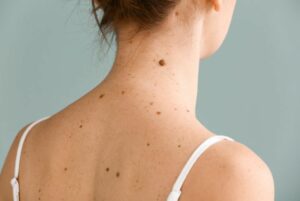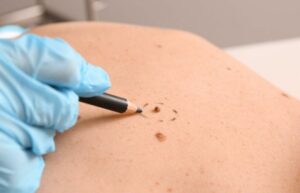Health
25th September, 2023Get Clear and Healthy Skin with Mole and Skin Tag Removal
With the hot weather of Queensland, it’s easy to become concerned or self-conscious about moles and skin tags. Even if a doctor determines they are harmless, many people choose to have them removed for confidence and comfort.
Whether you’re concerned about the appearance, location, or potential irritation caused by these skin imperfections, mole and skin tag removal can offer a simple and effective solution.

What are moles and skin tags?
Most of us know moles as small brown marks on our skin. More scientifically speaking, moles are clusters of pigmented skin cells that are either flat or raised and darker than the rest of your skin. While most moles are benign, some can change in shape, size, or colour, which is when they require medical attention.
Skin tags, on the other hand, are small growths that typically droop off the skin by a thin stalk. They are generally painless, but they can become irritated from things like weather or friction with clothing.
Why you may want to remove your moles and skin tags
People seek mole and skin tag removal for various cosmetic and medical reasons. Cosmetically speaking, moles and skin tags are often removed if they are in prominent or visible areas and impact someone’s self-esteem.
When it comes to medical reasons for removing moles and skin tags, doctors suggest this if there’s a suspicion of malignancy or if the growth is causing you discomfort. Other times, it’s just a matter of preventing the risk of skin tags becoming irritated or moles developing into potential health concerns.
How can moles and skin tags be removed?
There are several ways a mole or skin tag can be removed by your doctor. The method chosen will depend on factors like the size, location, and type of growth.
Excision is a popular choice that involves cutting the mole or skin tag off with a scalpel. This method is often used for larger growths that may not respond as well to other mole or skin tag removal options.
Cryotherapy is another option for removing moles or skin tags. This is where liquid nitrogen is applied to the area to freeze the growth, causing it to fall off over time. Removal by cryotherapy is particularly helpful for skin tags, as they are already somewhat disconnected from the skin.
Skin tags and moles can also be burnt off using electrocautery, where a small electrical current is used to burn the growth off the skin’s surface.
Lastly, there is ligation, a technique whereby the skin tag’s base is restricted with a piece of string or thread, cutting off its blood supply and allowing it to fall off.

Duration and pain of skin tag and mole removal
Although these removal methods can sound a little daunting, the reality is not at all concerning. Procedures, like cryotherapy and electrocautery, are relatively quick and minimally painful.
For excision by scalpel, your doctor will use local anaesthesia to numb the pain, and a longer recovery period might be expected for the area to heal. The duration and level of discomfort for skin tag and mole removal does vary depending on the chosen removal method however your doctor will always take every step to ensure your comfort during the treatment.
Pre-care and aftercare for skin tag and mole removal
Before your mole or skin tag removal, it’s essential to prepare for the procedure to ensure a smooth process and optimal results. First, you will need to schedule a consultation with a specialised GP to assess the growth and determine the best removal method. You may be asked to keep an eye on the mole’s size, shape and colour and told to look out for any changes in appearance before the procedure.
If your GP doesn’t know you and your health history in detail, be sure to inform them of any medications you’re taking, as some may need to be adjusted or discontinued temporarily. Leading up to your procedure, remember to maintain good skin hygiene in the treatment area to reduce any risk of infection.
After your mole or skin tag removal, caring for the treated area is important for proper healing and to minimise scarring. If your wound is exposed, keep the area clean by gently washing it with a mild and natural soap and warm water before patting it dry with a clean towel. If your wound is covered, you may need to replace any bandages or tape upon the direction of your GP.
During the healing time, avoid sun exposure and rubbing or picking the scab. Your doctor may suggest topical antibiotic ointments or creams to speed up the healing time. It is likely that your GP or specialist will request a follow-up appointment. Be sure to attend this, even if it seems like you’ve made good progress and healed well.
Book a Consultation for Skin Tag & Mole Removal at The Carina Medical & Specialist Centre
The doctors practising at Carina Medical & Specialist Centre will assess your skin condition and provide the best treatment to remove your skin tags or moles.
FAQs: Your Mole and Skin Tag Removal Questions Answered
Is it painful to have a mole or skin tag removed?
The level of pain with mole or skin tag removal varies depending on the removal method your doctor chooses, for larger procedures your doctor will use local anaesthesia to numb the pain. Most methods are relatively quick and cause only mild discomfort.
Does mole or skin tag removal cause scarring?
Scarring is possible, but the degree depends on factors like the removal method, the size and location of the growth, and your skin type. Your healthcare provider will discuss scarring potential during your consultation and may even suggest creams and care to reduce the possibility and severity.
How long does it take to heal after removal?
The healing time varies but typically ranges from a few days to a few weeks. Your doctor will provide specific aftercare instructions to speed up the healing process and can give a more accurate estimate of healing based on your situation.
Can I remove moles or skin tags at home?
DIY skin tag and mole removal can lead to infection, scarring, incomplete removal and medical complications. Under no circumstances do we recommend removing your own mole or skin tag. Leave it to the professional healthcare providers here at The Carina Medical & Specialise Centre.


